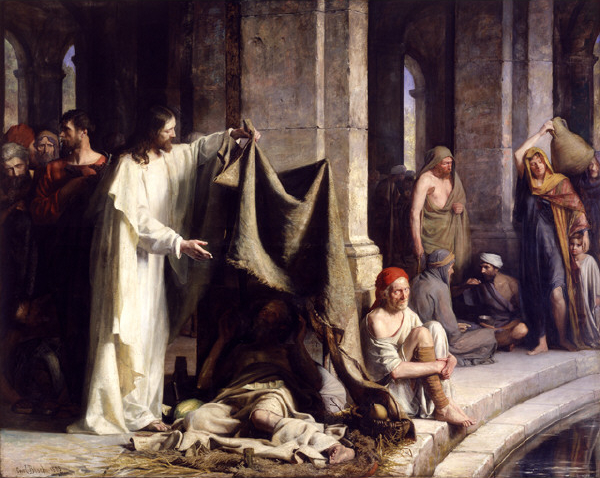A few days ago my son Ben (9) and I went to the Carl Bloch exhibit at BYU's Museum of Art to see the four stunning altarpieces and the incredible in-house original of Bloch's "Christ Healing the Sick at Bethesda":

We rented i-Pads for the experience, so we were both throttled with a cable lanyard and both equally distracted from the paintings by the supplemental media. As we sat in front of the first altarpiece--a stunning rendition of Jesus in Gethsemane being comforted by an androgynous angel with white wings--Ben kept his head down, watching video commentary from the MOA's religion staff and a few female church leaders from the Danish Lutheran church that loaned out the paintings.
At first it frustrated me to see my boy sitting in front of a religious masterwork with his head down, swiping his finger across a screen that gave him an interactive panorama of the inside of the Skt. Nikolai Kirke Holbaek (check out the panoramas here). How can any art, let alone religious art, compete with the multimodality of the i-Pad? But then I caught myself staring down at the screen, swiping my greasy finger around, watching videos, ignoring the painting.
But we weren't really ignoring the painting. Our heads were tick-tocking back and forth from painting to Pod. And we were participating in a new kind of religious visual culture in which multiple modes collaborated with each other to "embolden and intensify inner or imaginative vision," as David Morgan writes in The Sacred Gaze. Until the moment I was captivated by my first use of an i-Pad, I had not thought much about how digital "iconicity" could create a new kind of experience with religious aesthetics. I understand how someone would resent having their aesthetics layered with multimodal mediation; after all, the folks on the screen essentially were telling me and Ben where, what, and how to look at these paintings. Our sacred gaze--which Morgan defines as "the particular configuration of ideas, attitudes, and customs that informs a religious act of seeing"--was tutored by a slick Mac product with a tactile interface. The tutoring, though, made my untrained eye more focused than it would have been. Without experience or expert knowledge, I invited the tutoring. We both assented to the MOA's efforts to catalyze a religious experience through 19th century art and 21st century technology.
At the end of the exhibit, Ben wrote on the comment blog that he'd expected the exhibit to be boring but had (really!) enjoyed himself. I suppose my resistance was a kind of digital iconophobia, a fear of what a digital interface would do to distract my son from the materiality of the art itself.
Brian, I so enjoy reading these posts. It keeps a rhetorical mindset in my world more often. Thanks!
ReplyDeleteA student celebrating the "rhetorical mindset" after leaving the course?? What could be better?
ReplyDeleteThanks, Sydney, for the boost!
Kind of highlights the way that using art has changed. I mean, alter pieces like Bloch's used to be what people stared for hours at when they wanted a distraction from a dull sermon. Healing the Sick was the iPad of the day and now we're supposed to stare at the didactic detail primarily in a silent museum, and we get distracted by didactic digital tutoring of the tour.
ReplyDeleteWe use ipads to learn about things, we use art to feel about things, or beyond things. There might be a pecking order involved, but I imagine Ben learning from the multiple modes right now is enough. But at one point he might return to the painting, ready have the experience sans ipad. And the experience will be different.
ReplyDeleteRight, Mary. There is no non-mediated religious experience, then? Or have we simply added another layer?
ReplyDeleteJames, what pecking order do you propose? After reading Hamlet's Blackberry yesterday, I wonder if I've been hoodwinked by the Power of the Screen.